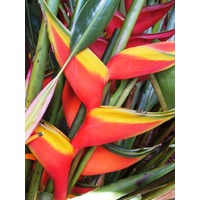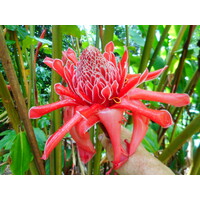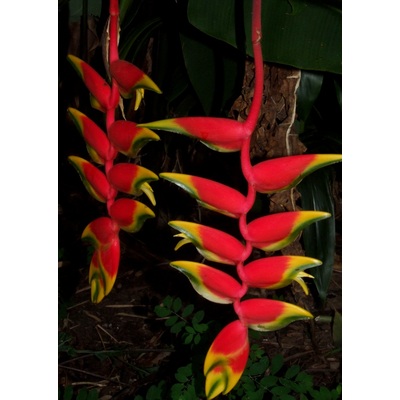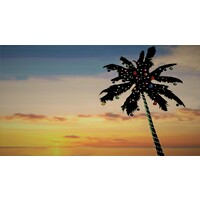

When to Order
Generally we recommend purchasing plants in early spring so that you have a full growing season before winter arrives. You are free to order plants at anytime from us but if you do not follow our advice we cannot be held responsible if you choose not to follow that advice. There are some exceptions to this rule as we find NT customers prefer to order at the end of the wet and North Queensland customers will often order after February.
If you are in SE Qld we recommend purchasing heliconias and gingers before Christmas but things like cordylines are fine through autumn.
If you have a hothouse and can maintain a constant temperature above 15 degrees then your plants should be O.K. even if you order in winter but we cannot be held responsible if they damaged by the cold in transit or you cannot care for them properly so please consider if ordering in winter is your only option..
Ordering and establishing plants when it is above 30 degrees is not recommended. Ideally temps should be between 20 and 27 degrees.
We strongly recommend you consider your climate and do some research into your plants to make sure you are ordering at an appropriate time for your area.
In winter of 2019 we will be sending plants on the dates listed on the home page of the website. Roughly it works out to every other week.
Plants purchased in winter will require special care. Tropical plants will need to be kept in a hothouse or somewhere where temperatures are consistently over 15 degrees with bright light. You can pot your plants up and keep them as indoor potplants for winter and then plant in spring. We are not responsible for cold damage due to travelling in winter.
When You Receive Your Plants
When you receive your plants unwrap them carefully and place them in a pot and add a high quality free draining potting mix (not garden soil). Generally the pot should be the smallest the plant fits in. If the pot is too large the plants will be prone to fungus and rot. Most of our plants will go into 140 mil to 200 mil pots.
Water the plants in well with a seaweed/seasol solution. It is extremely important to water plants in when they are potted up. Continue to use a weak seasol or kelp solution once a week until plants are established. Seaweed will strengthen your plants and fish emulsion has a broad range of micronutrients.
Place in a shadehouse or a spot with indirect light, gradually increasing light exposure. Remember your plants have been in a dark box and are not ready to go directly into sunlight. .
Water regularly as the soil drys out but do not overwater.
Fertilize with a organic extra or chicken pellet fert and what till roots establish through the pot.
You can now plant your plants in the ground.
I f you choose to place plants directly in the ground you will not have as much control over light and water and your success rate may not be as high. But if you do choose to do so make sure plants and mulched, watered regularly and protected from intense light.
Your plants may have brown, yellow, or damaged leaves or have been cut back for posting.. Uprooting your selected tropical plants from their optimum growing environment, cleaning them, soaking in kelp, then packing them inside a dark box, surrounding them by shredded paper and/or banding box, then shipping via truck and/or airplane to you with greatly varying temperatures and humidities, then waiting for you to unpack and plant it and place it back into its optimum environment. If planted promptly upon receipt in the correct type of potting soil and placed in the correct light conditions and not over-watered or over-fertilized they will revive quickly and put out new growth to replace yellowed or damaged leaves. The single factor that kills most plants is over watering. Plant roots need oxygen; they cannot get oxygen with roots standing in water unless they are water plants. The second most common cause of killing a plant is too much fertilizer. If a plant does not have a good leaf system and a good root system it cannot take a lot of water or full strength fertilizer. Start out slowly until you see the plant responding favorably by putting out new green leaves and developing a good root system. Too much care can be the death knell for an otherwise healthy plant.
If you have any questions about caring for your plants please contact us when the arrive. That's when we can give you advice on keeping your plant healthy, not when they or dead or you have improperly cared for them.
Fertilizing Your Plants
For fertilizing your tropical plants we recommend that you use fertilizers that work to improve your soil as well as fertilize your plants. Blood and Bone, Organic Extra, Seasol and Charlie Carp are all excellent soil builders as well as mushroom compost and cow dung.
We also recommend mulching your plants regularly!!!!.
The majority of plants we sell do best in well drained rich soil. Although many experienced tropical gardeners are aware of this there are a few that are unsure as to what it means.
As a general rule most heliconias and gingers originate from tropical rainforests. These rainforest soils are generally teaming with life and rich in organic matter and nutrients in the form of leaf mulch and decaying vegetation. Heliconias and gingers are quite literally built for top feeding with their shallow root systems from these rich soils. Although they can be grown in a range of conditions,the closer you can come to duplicating these soil conditions the better your results will be. There are a few things that can impact negatively on growth and flowering. Lack of water and humidity is one of them. Poor drainage is another.Torch gingers and a few heliconias like Standleyii will thrive in poor drainage but for the most part good drainage is a necessity.
Practically speaking, if you have sandy soil you'll find that by adding organic matter, watering regularly, mulching and fertilizing a few times a year(spring and summer) that your plants will do best. In heavy clay soils you'll need to add gypsum and lime to break up your clay (which increases drainage) and raise your PH (which will help make nutrients more available to your plants)
When in doubt MULCH!!! You can never underestimate the value of good preparation when creating your tropical garden. Like the saying goes, there's no point in putting a twenty dollar plant in a twenty cent hole.
We cannot be held responsible if you do not follow advice/instructions given to you on purchasing or caring for your tropical plants. PLEASE READ ALL INFORMATION PROVIDED BEFORE ORDERING!!!!!











